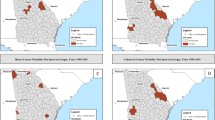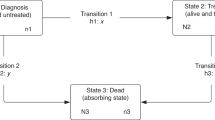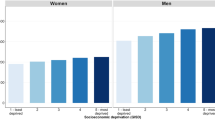Abstract
Background:
We examine the relationships between geographic remoteness, area disadvantage and risk of advanced colorectal cancer.
Methods:
Multilevel models were used to assess the area- and individual-level contributions to the risk of advanced disease among people aged 20–79 years diagnosed with colorectal cancer in Queensland, Australia between 1997 and 2007 (n=18 561).
Results:
Multilevel analysis showed that colorectal cancer patients living in inner regional (OR=1.09, 1.01–1.19) and outer regional (OR=1.11, 1.01–1.22) areas were significantly more likely to be diagnosed with advanced cancer than those in major cities (P=0.045) after adjusting for individual-level variables. The best-fitting final model did not include area disadvantage. Stratified analysis suggested this remoteness effect was limited to people diagnosed with colon cancer (P=0.048) and not significant for rectal cancer patients (P=0.873).
Conclusion:
Given the relationship between stage and survival outcomes, it is imperative that the reasons for these rurality inequities in advanced disease be identified and addressed.
Similar content being viewed by others
Main
While colorectal (CRC) survival rates in Australia are among the highest in the world (Coleman et al, 2011), people living outside major cities or in disadvantaged areas have poorer prognosis (Yu et al, 2005; Kelsall et al, 2009). Since stage at diagnosis is a major predictor of long-term CRC outcomes (Altekruse et al, 2010), its relationship to factors such as socio-economic status (SES) and geographic remoteness is of particular relevance for cancer control. With major medical centres being concentrated in densely populated urban centres, it has been suggested that rural and remote locations may be associated with poorer access to screening and specialised health care (Parikh-Patel et al, 2006; Heathcote and Armstrong, 2007). However ecological studies have presented a mixed picture in terms of SES (Parikh-Patel et al, 2006; Frederiksen et al, 2008; Henry et al, 2009; Booth et al, 2010) and geographic remoteness (Fazio et al, 2005; McLafferty and Wang, 2009; Sankaranarayanan et al, 2009) in stage at diagnosis.
Most of the evidence is based on ecological studies and these are not able to separate the area-level or individual-level influences (Baade et al, 2010), limiting our understanding about area-level health inequalities. To date, no Australian study has employed multilevel methods to investigate links between geographic remoteness, area disadvantage, individual-level factors and advanced CRC.
Materials and methods
Ethical approval to conduct this study was obtained from the University of Queensland and Queensland Health. Data for individuals aged 20–79 years diagnosed with invasive stage 1–IV CRC (ICD-O3 codes C18 to C20, C21.8) in Queensland between 1 January 1996 and 31 December 2007 (inclusive) (n=18 561) with complete address information were extracted from the Queensland Cancer Registry (QCR).
Information extracted from pathology forms (Krnjacki et al, 2008) was used to determine stage at diagnosis according to TNM system (Sobin and Wittlekind, 2002) as described previously (Baade et al, 2011). For multivariate analysis, localised cases (Stages I–II) were considered as early stage (Parikh-Patel et al, 2006; Henry et al, 2009) while regional and distant cases were categorised as ‘advanced’ based on their lower survival rates (Altekruse et al, 2010).
Information was obtained from QCR on individual-level variables: year and age of diagnosis, cancer site, gender, marital status, occupation (Turrell et al, 2007) and indigenous status (see Table 2 for categories).
Statistical Local Areas (SLAs), which are typically based on local governments and councils and thus likely to be socio-economically relevant to their residents, were used as the geographical definition for area-level analysis (Baade et al, 2010). Remoteness of residence was defined using the Accessibility/Remoteness Index of Australia (ARIA+) classification (AIHW, 2004) and area-level socio-economic disadvantage measured using the Index of Relative Socio-economic Disadvantage (IRSD) (Australian Bureau of Statistics, 2006) which categorises SLAs into five quintiles of increasing advantage from quintile 1.
Modelling
Multilevel logistic modelling (MLwiN 2.21) using Markov Chain Monte Carlo (Browne, 2009) approaches in MLwiN version 2.21 (University of Bristol, UK) was used. Chain convergence was checked using Raftery-Lewis diagnostics. Models were compared using the Bayesian deviance information criterion (DIC; Spiegelhalter et al, 2002), with smaller values indicating better fit.
Analyses were conducted in three steps: (1) a null model comprising individuals (Level 1) nested in SLAs (Level 2) with no fixed effects; (2) extending to include individual-level factors as fixed effects (Model 2); and (3) geographic remoteness (Model 3) and neighbourhood disadvantage (Model 4) were included separately as fixed effects to quantify how much area variation in stage was due to these factors independent of compositional effects, and then in combination (Model 5). Fixed effects results are reported as odds ratios (95% CI) (Merlo et al, 2001; Eikemo et al, 2008). Significance of individual coefficients was tested using Z test.
Results
Overall, 57.1% of patients were male with 67.2% having colon cancer. The mean age at diagnosis was 65 years (median=66 years). About 44.8% were diagnosed with advanced CRC. Just over half of the patients (57.6%) lived in major cities and around 36.5% were in the two most affluent SES quintiles.
In the multivariable logistic regression analyses, the null model (Model 1) indicated significant (P=0.041) between area variations across the SLAs (Table 1).
Based on the DIC statistic (Table 1), the model fit improved substantially by including individual-level characteristics (Model 2) and then geographic remoteness (Model 3). Adding area disadvantage (Model 4) to Model 2 did not improve the fit. Similarly, the full model (Model 5) provided a poor fit to the data than Model 3, suggesting that Model 3 was the best-fitting model for these data. There was no evidence for area-level interaction (results not shown).
In this final model (Model 3), and independent of individual factors, geographic remoteness was associated with cancer stage (Table 2). At individual level sex, occupation, indigenous status and anatomic site were independent predictors (P<0.001) of advanced CRC (Table 2). Independent of area effects the likelihood of advanced CRC was significantly higher for females than for males; blue-collar workers vs professionals; individuals with known indigenous status compared with unknown and patients with colon rather than rectal cancer (Table 2).
Analyses stratified by cancer site (Model 3) (results not shown) showed that area remoteness was significant for colon cancer (P=0.048) but not for rectal cancer (P=0.873).
Discussion
This study is one of the first to consider geographical variations in CRC stage at diagnosis after adjusting for both area- and individual-level factors. We found significant evidence that a person's risk of being diagnosed with advanced CRC depends on where they live, specifically for those diagnosed with colon cancer, independently of the individual characteristics of the patient themselves. The impact of geographical location, however, was limited to rurality with no evidence that area disadvantage was associated with stage at diagnosis.
Given the nature of our data, any discussion of the possible reasons for the remoteness differential can only be speculative; but these may include a relative shortage of experienced medical staff in regional areas and greater difficulty of accessing diagnostic services.
Significantly higher risks of late-stage diagnosis were seen for patients with colon vs rectal cancer, consistent with international studies (Frederiksen et al, 2008; Sankaranarayanan et al, 2009). We also found that the risk of advanced disease was higher in more regional areas compared with major cities for colon cancers only. A contributing reason for both these observations may be that compared with colon cancer rectal cancer often presents with more visible symptoms (Majumdar et al, 1999), thereby making patients more likely to seek medical care and be diagnosed earlier.
The strengths of this study include the use of staged CRC cases from a large, unselected, state-wide population-based registry. Approximately 84% of records in our initial cohort had sufficient information to be staged similar to that reported elsewhere (Yu et al, 2008). We were limited to the individual-level SES variable of occupation, since the QCR does not collect information about education (Frederiksen et al, 2008), income (Frederiksen et al, 2008) or private insurance status (Halpern et al, 2009) known to be associated with advanced CRC. In addition, due to the high prevalence of advanced CRC the odds ratios may reflect an overestimation of the relative risk.
Conclusion
Given the relationship between stage at diagnosis and survival outcomes, it is imperative that the reasons for the geographical inequities in advanced disease be identified and addressed.
Change history
29 March 2012
This paper was modified 12 months after initial publication to switch to Creative Commons licence terms, as noted at publication
References
AIHW (2004) Rural, Regional and Remote Health: A Guide to Remoteness Classifications. Australian Institute of Health and Welfare AIHW Cat. No. PHE 53: Canberra
Altekruse S, Kosary C, Krapcho M, Neyman N, Aminou R, Waldron W, Ruh LJ, Howlade RN, Tatalovich Z, Cho H, Mariotto A, Eisner M, Lewis D, Cronin K, Chen H, Feuer E, Stinchcomb D, Edwards BE (2010) SEER Cancer Statistics Review, 1975–2007. In http://seer.cancer.gov/csr/1975_2007/ based on November 2009 SEER data submission, posted to the SEER web site, 2010
Australian Bureau of Statistics (2006) Census of Population and Housing: Socio-Economic Indexes for Areas (SEIFA), Australia, 2006. ABS: Canberra
Baade PD, Dasgupta P, Turrell G, Aitken JF (2011) Association between survival and distance to closest radiation treatment facilities for people diagnosed with rectal cancer in Queensland, Australia. Med J Aust; e-pub ahead of print 19 September 2011, doi:10.5694/mja10.11204
Baade PD, Turrell G, Aitken JF (2010) A multilevel study of the determinants of area-level inequalities in colorectal cancer survival. BMC Cancer 10: 24
Booth CM, Li G, Zhang-Salomons J, Mackillop WJ (2010) The impact of socioeconomic status on stage of cancer at diagnosis and survival. Cancer 116: 4160–4167
Browne WJ (2009) MCMC estimation in MLwin v2.1. Bristol, UK.
Coleman MP, Forman D, Bryant H, Butler J, Rachet B, Maringe C, Nur U, Tracey E, Coory M, Hatcher J, McGahan CE, Turner D, Marrett L, Gjerstorff ML, Johannesen TB, Adolfsson J, Lambe M, Lawrence G, Meechan D, Morris EJ, Middleton R, Steward J, Richards MA (2011) Cancer survival in Australia, Canada, Denmark, Norway, Sweden, and the UK, 1995–2007 (the International Cancer Benchmarking Partnership): an analysis of population-based cancer registry data. Lancet 377: 127–138
Eikemo TA, Bambra C, Judge K, Ringdal K (2008) Welfare state regimes and differences in self-perceived health in Europe: a multilevel analysis. Soc Sci Med 66: 2281–2295
Fazio L, Cotterchio M, Manno M, McLaughlin J, Gallinger S (2005) Association between colonic screening, subject characteristics, and stage of colorectal cancer. Am J Gastroenterol 100: 2531–2539
Frederiksen BL, Osler M, Harling H, Jorgensen T (2008) Social inequalities in stage at diagnosis of rectal but not in colonic cancer: a nationwide study. Br J Cancer 98: 668–673
Halpern MT, Pavluck AL, Ko CY, Ward EM (2009) Factors associated with colon cancer stage at diagnosis. Dig Dis Sci 54: 2680–2693
Heathcote K, Armstrong BK (2007) Disparities in cancer outcomes in regional and rural Australia. Cancer Forum 31: 70–74
Henry KA, Sherman R, Roche LM (2009) Colorectal cancer stage at diagnosis and area socioeconomic characteristics in New Jersey. Health Place 15: 505–513
Kelsall HL, Baglietto L, Muller D, Haydon AM, English DR, Giles GG (2009) The effect of socioeconomic status on survival from colorectal cancer in the Melbourne Collaborative Cohort Study. Soc Sci Med 68: 290–297
Krnjacki LJ, Baade PD, Lynch BM, Aitken JF (2008) Reliability of collecting colorectal cancer stage information from pathology reports and general practitioners in Queensland. Aust NZJ Public Health 32: 378–382
Majumdar SR, Fletcher RH, Evans AT (1999) How does colorectal cancer present? Symptoms, duration, and clues to location. Am J Gastroenterol 94: 3039–3045
McLafferty S, Wang F (2009) Rural reversal? Rural-urban disparities in late-stage cancer risk in Illinois. Cancer 115: 2755–2764
Merlo J, Ostergren PO, Broms K, Bjorck-Linne A, Liedholm H (2001) Survival after initial hospitalisation for heart failure: a multilevel analysis of patients in Swedish acute care hospitals. J Epidemiol Community Health 55: 323–329
Parikh-Patel A, Bates JH, Campleman S (2006) Colorectal cancer stage at diagnosis by socioeconomic and urban/rural status in California, 1988–2000. Cancer 107: 1189–1195
Sankaranarayanan J, Watanabe-Galloway S, Sun J, Qiu F, Boilesen E, Thorson AG (2009) Rurality and other determinants of early colorectal cancer diagnosis in Nebraska: a 6-year cancer registry study, 1998–2003. J Rural Health 25: 358–365
Sobin LH, Wittlekind C (2002) TNM Classification of Malignant Tumours 6th edn. John Wiley and Sons: New York
Spiegelhalter DJ, Best NG, Carlin BP, Van Der Linde A (2002) Bayesian measures of model complexity and fit. J R Stat Soc Ser B (Stat Meth) 64: 583–639
Turrell G, Kavanagh A, Draper G, Subramanian SV (2007) Do places affect the probability of death in Australia? A multilevel study of area-level disadvantage, individual-level socioeconomic position and all-cause mortality, 1998–2000. J Epidemiol Community Health 61: 13–19
Yu XQ, O'Connell DL, Gibberd RW, Armstrong BK (2005) A population-based study from New South Wales, Australia 1996–2001: area variation in survival from colorectal cancer. Eur J Cancer 41: 2715–2721
Yu XQ, O'Connell DL, Gibberd RW, Abrahamowicz M, Armstrong BK (2008) Misclassification of colorectal cancer stage and area variation in survival. Int J Cancer 122: 398–402
Acknowledgements
This study was supported by a grant from the (Australian) National Health and Medical Research Council (NHMRC) (ID561700). Associate Professor Peter Baade is supported by an NHMRC Career Development Fellowship (ID1005334); Professor Gavin Turrell is supported by an NHMRC Senior Research Fellowship (ID 1003710).
Author information
Authors and Affiliations
Corresponding author
Ethics declarations
Competing interests
The authors declare no conflict of interest.
Rights and permissions
From twelve months after its original publication, this work is licensed under the Creative Commons Attribution-NonCommercial-Share Alike 3.0 Unported License. To view a copy of this license, visit http://creativecommons.org/licenses/by-nc-sa/3.0/
About this article
Cite this article
Baade, P., Dasgupta, P., Aitken, J. et al. Geographic remoteness and risk of advanced colorectal cancer at diagnosis in Queensland: a multilevel study. Br J Cancer 105, 1039–1041 (2011). https://doi.org/10.1038/bjc.2011.356
Received:
Revised:
Accepted:
Published:
Issue Date:
DOI: https://doi.org/10.1038/bjc.2011.356
Keywords
This article is cited by
-
Cancer survival differentials for Aboriginal and Torres Strait Islander peoples in Queensland: the impact of remoteness
Cancer Causes & Control (2023)
-
A systematic review of geographical differences in management and outcomes for colorectal cancer in Australia
BMC Cancer (2017)
-
The Improving Rural Cancer Outcomes Trial: a cluster-randomised controlled trial of a complex intervention to reduce time to diagnosis in rural cancer patients in Western Australia
British Journal of Cancer (2017)
-
Risk of Several Cancers is Higher in Urban Areas after Adjusting for Socioeconomic Status. Results from a Two-Country Population-Based Study of 18 Common Cancers
Journal of Urban Health (2014)
-
Health-related quality of life and life satisfaction in colorectal cancer survivors: trajectories of adjustment
Health and Quality of Life Outcomes (2013)



